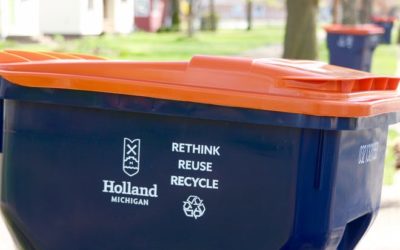by Laura Thompson
Commonly referred to as the number one recycling contaminant, plastic bags and other film products like paper towel wrap and overwrap on cans and bottles can be a real nuisance for many recycling programs. Very few municipalities offer curbside collection programs that include these materials, and most communities’ websites include clear instructions to keep plastic film out, such as those depicted here.

Yet consumers continue to place bags and film in their recycling bins, causing equipment shutdowns at material recovery facilities (MRFs) and preventing these items from being recycled through the correct outlets.
Recent data indicates that only 4 percent of products made from recyclable polyethylene (PE) film is currently recovered from households by consumers returning them to retail locations. These items do have end markets and can be recycled when taken to the right location.
Because plastic bags are only a fraction of common film materials in households, it’s important that we collectively continue to educate consumers to think beyond the bag. For example, the growth of e-commerce brings bubble wrap and air pillows into the home (return to retail). Retailers also appear to be using more film mailers to cut down on corrugated containers (aka cardboard boxes).
While bag bans continue to expand at both municipal and state levels, we must also implore retailers to keep collecting bags and film. Even if we take plastic bags out of the mix, the data suggests we’d still have more than 3 billion lbs. of film on our hands each year (or roughly 25 lbs. of film in every household). The case wrap around multi-pack products of all types (cans, bottles, tissue, towel and more) is estimated to be more than 900 million lbs. per year. The store drop-off channel is currently the best means to get these materials out of landfills and into the recycling value chain.
The good news is that two of the leading consumers of retail film recently indicated that they have capacity to process more film. Novolex indicated that their plastic bags are, on average, 30 percent recycled content – but that they could do 100 percent – if they could get the supply. Similarly, Trex has indicated that they are “expanding its base of participating retailers and consumers” through their recently rebranded NexTrex collection program.
The Sustainable Packaging Coalition (SPC) reports continued growth of their How2Recycle labeling program. Walmart, Target and numerous grocery chains are adding labels to their own branded products and encouraging their suppliers to do so as well.
In an effort to find solutions to film recycling, The Recycling Partnership has deployed its Film and Flexibles Task Force. The team is continuing to search for solutions for recycling this material, as its presence is increasingly growing in the stream, and there is a need for the system to adapt with these changes in packaging.
(That’s a wrap!)
Laura Thompson is the Senior Director of Strategic Partnerships for The Recycling Partnership. For more information about the Film and Flexibles Task Force, contact Laura at lthompson@recyclingpartnership.org.

